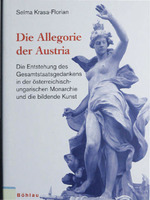Die Allegorie der Austria
Die Entstehung des Gesamtstaatsgedankens in der österreichisch-ungarischen Monarchie und die bildende Kunst
Author(s)
Krasa-Florian, Selma
Collection
Austrian Science Fund (FWF)Language
GermanAbstract
The intention of this paper is to give a correct inside in the review of the discussed periods. It tries to achieve this by using the means of Art History and Political History to get an exact inside. The allegorical representation of the Austria in this case is the means to get it. It stands for the specific aspects of the time, so for instance the dynastic Austria with the crown of Emperor Rudolph II. meaning the predominance of the ruling Habsburgs, the civic Austria with the mural crown showing the ideas of the middle class, especially in the German speaking parts of the country, with the acceptance of the predominance of the state over the ruler, according to Hegel, or also the victorious Austria with the laurel wreath as a symbol of the conquest of the revolution of 1848. The Habsburg monarchy including many different nations was the proper breeding ground of dissatisfaction and diversified nationalistic ideas. So the representation of the Austria is an important means of showing these ideas. The periods the paper is working on are roughly speaking starting with the time of the beginning of the position of the monarchy as one of the ruling powers of Europe until her dissolution and the end of World War I. Different aspects of art history are also dealt with. So for example the 13 portraits of Habsburg rulers in the Museum Nordico at Linz, which are positioned in the time of Rudolph II. and mark the beginning of the representation of the allegory of the Austria, or the designs for monuments by Otto Wagner which are dealt with in the many books on this architect only as a side issue, whereas they are a very important part of wagners work and show his national feelings, towards his fatherland. It is furthermore interesting to look at the nationalistic problems shown in this paper and compare them with contemporary Europe and the overcoming of them. These ideas are not new, the date back to the 19th and especially the beginning of the 20th century when the Monarchy tried to overcome the problems with the slogan of Großösterreich (Greater Austria). During World War one followed the idea of Mitteleuropa (Central Europe) including Turkey and the institution of a Polish State to hold off revolutionary Russia Diese Arbeit ist der Versuch, durch die Verbindung von kunsthistorischen und politikgeschichtlichen Erkenntnissen ein genaueres korrekteres Bild der behandelten Epochen zu erhalten. Die Allegorie der Austria ist dabei das Instrument zur genauen Evaluierung der jeweiligen nationalen und staatspolitischen Vorstellungen. Die Allegorie der Austria verkörpert dabei sehr genau die jeweiligen politischen Konstellationen. Die dynamische Austria mit der rudolphinischen Hauskrone bedeutet die Prädominanz des Herrscherhauses, die bürgerliche Austria mit der Mauerkrone die Vorstellungen dieser Bevölkerungsschicht, vor allem im deutschsprachigen Teil von Österreich, die Stellung des Staates über dem Herrscher der Sinne Hegels, sowie auch die siegreiche Austria mit dem Lorbeerkranz als Zeichen der Überwindung der Revolution von 1848. Gerade im Vielvölkerstaat der Habsburger, wo die divergierenden gesamtstaatlichen und nationalen Sichtweisen zu Konflikten führen mußten, ist so die Allegorie der Austria ein wichtiger Hinweis auf die jeweilige Stellung der Öffentlichkeit zu der angedeuteten Problematik. Der in der Arbeit vorgegebene Zeitraum umfaßt die Periode vom Beginn des Aufstiegs Österreichs zur Großmacht bis zum Ende der Monarchie nach dem ersten Weltkrieg. Dabei werden verschiedene künstlerische Aspekte in einer neueren und genaueren Betrachtungsweise angesprochen, wie zum Beispiel der Zyklus von 13 Porträts aus dem Umfeld von Rudolph II. im Linzer Museum Nordico, die in der großen Ausstellung über diesen Herrscher "Prag um 1600" nicht repräsentiert waren und die am Beginn der Austria-Allegorie in der bildenden Kunst stehen, oder die Denkmalsentwürfe Otto Wagners, die im Großteil der Literatur über diesen Architekten nur als Gelegenheitsentwürfe bezeichnet werden, aber in Wahrheit ernstzunehmende Auseinandersetzungen Wagners mit der nationalen Kunst sind. Ein weiterer gedanklicher Ansatzpunkt ist der Vergleich des Ringens um einen modernen Gesamtstaat vor allem seit dem Anfang des 20. Jahrhunderts im Verhältnis zum heutigen Europa mit seinen überstaatlichen Strukturen. Dazu gehört die im Weltkrieg aufgekommene Idee von Mitteleuropa unter Einschluß der Türkei und der Wiedererrichtung des Königreiches Polen als Pufferstaat gegenüber dem revolutionären Russland. Hier ist schon lange vor der Gründung der europäischen Union der Versuch gemacht, den Kontinent friedlich zu einen.
Keywords
allegorical representation of Austria; Deutschland; Monarchie; Österreich; Ungarn; WienDOI
10.26530/oapen_437140ISBN
9783205775805OCN
1030814324Publisher
BrillPublisher website
https://brill.com/Publication date and place
2007Grantor
Imprint
BöhlauClassification
The Arts


 Download
Download